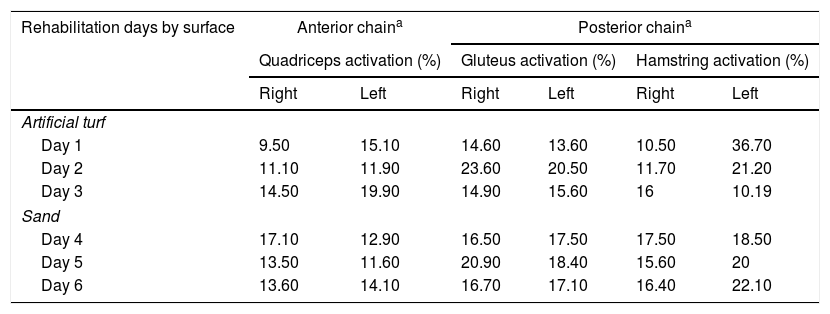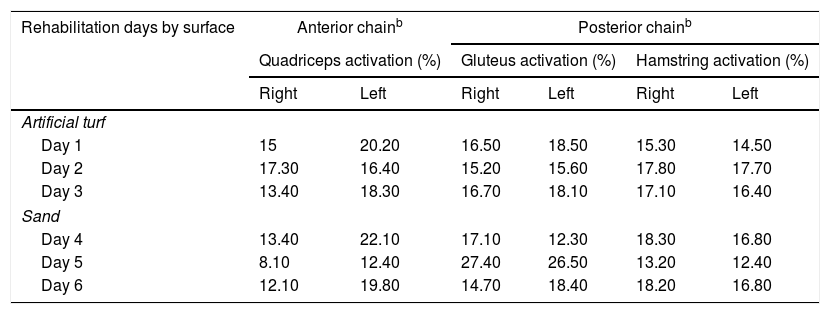Performing the rehabilitation of a player on a surface different from the normally used by the athlete in her/his sport is beneficial. By recruiting more muscle fibers in the new surface, the rehabilitation process is enhanced. Here, we describe the electromyography (EMG) data of anterior and posterior chains during workouts on two different surfaces: sand and artificial turf. We recorded data using a Myontec EMG device of two anterior cruciate ligament (ACL) injured women's soccer players. Player 1 was injured on her left leg in the ACL and the patellar tendon, and player 2 was injured on her right leg in the ACL and semitendinosus plasty. The EMG results of player 1 showed an increase in the activation of the cross pattern (i.e. left hamstring and right gluteus) of the posterior chain. Similarly, the EMG data of player 2 showed an increase in the activation of the left quadriceps (the antagonist muscle of her injured leg) of the anterior chain. In conclusion, in both players the muscle group most activated during rehabilitation was the antagonist of the injured leg's muscle, regardless of the surface used.
In the last decade, there has been an increasing demand for scientific research in sports medicine, especially to improve performance and rehabilitation. In this sense, a relatively new approach for training and injury recovery has consisted in the use of surfaces alternative to those used by the athlete in her/his sport, for instance sand for soccer players.1 Changing training surfaces has proven to be a valuable strategy to improve a player's rehabilitation, since exercises on sand have been postulated to recruit more muscle fibers than those performed on grass.2
The strength and power of the muscle depends on the amount and quality of the nerve stimulus received by the motor units of the muscle.3 This stimuli can be measured with electromyography (EMG). The EMG of the lower extremity when exercising on sand has shown a greater activation of the stabilizing muscles around the ankle, knee, and hip compared to the EMG of the same workout on grass. This may be explained by the instability caused by sand and the greater contact time experienced on this surface with respect to grass.4,5 Recently, a new surface EMG device (Mbody AllSport 6Channel surface EMG mesh or Myontec EMG) has been made available that allows the monitoring of the level of activity of agonist, antagonist, and synergistic muscles during training or any activity.6 Herein, we describe the EMG data during workouts of the anterior and posterior chains on two different surfaces of two anterior cruciate ligament (ACL) injured players.
Case report: player 1, injured on left leg (ACL and patellar tendon)We monitored a 17-year old woman who played as lateral in Barcelona Football Club women's soccer division. She was 1.57m tall and weighed 49.5kg. She underwent surgery in the ACL of her non-dominant limb for skills with ball (left), as well as on her patellar tendon on April 2018. She needed seven months of rehabilitation before returning to play.
We collected data through the Mbody AllSport 6Channel surface EMG mesh during the first 6 days of the mesh adaptation sessions, while she was performing the exercises. The rehabilitation sessions consisted of gym and outdoor workouts. Firstly, she performed the gym component, which consisted of 10min warm-up on the stationary bicycle then functional work that encompassed the entire lower extremity muscle, proprioception, and core. Secondly, the outdoor component was composed of running exercises of 15–20min. In all six sessions she was asked to go at a progressive pace until she reached 80% of her maximum speed. During the first three sessions, she performed linear runs on artificial turf (Fig. 1). The following three sessions were performed on sand; during the first session she performed linear runs on the sand and during the subsequent two sessions she performed, in addition, work on changes of direction (Fig. 2).
During the six sessions, the anterior chain of the left quadriceps was more activated on artificial turf than on sand, with a highest absolute value of 19.90%. The highest absolute value for the right quadriceps was 14.50%. During the first two days on sand, there was an increase in the activation of the right quadriceps with respect to the left one, with a maximum difference of 5.60% on the first day. However, this difference decreased gradually to reach a value of 0.50% (in favor of the right quadriceps) in the last session (Table 1).
Electromyography results for player 1.
| Rehabilitation days by surface | Anterior chaina | Posterior chaina | ||||
|---|---|---|---|---|---|---|
| Quadriceps activation (%) | Gluteus activation (%) | Hamstring activation (%) | ||||
| Right | Left | Right | Left | Right | Left | |
| Artificial turf | ||||||
| Day 1 | 9.50 | 15.10 | 14.60 | 13.60 | 10.50 | 36.70 |
| Day 2 | 11.10 | 11.90 | 23.60 | 20.50 | 11.70 | 21.20 |
| Day 3 | 14.50 | 19.90 | 14.90 | 15.60 | 16 | 10.19 |
| Sand | ||||||
| Day 4 | 17.10 | 12.90 | 16.50 | 17.50 | 17.50 | 18.50 |
| Day 5 | 13.50 | 11.60 | 20.90 | 18.40 | 15.60 | 20 |
| Day 6 | 13.60 | 14.10 | 16.70 | 17.10 | 16.40 | 22.10 |
Regarding the posterior chain, during the first days on artificial turf the muscle that worked the most was the left hamstring, with an activation of 36.70%. In contrast, the right hamstring showed an activation value of 10.50%. On artificial turf, the most activated muscle groups were the left hamstring and the right gluteus. The same pattern was repeated on sand, but the difference in activation between muscle groups was smaller, with a decreasing trend on the activation difference of the glutei. However, the left hamstring was invariably more activated than the right one, displaying the highest difference during the first day (26.20%) and the smallest during the last (5.70%) (Table 1).
Case report: player 2, injured on right leg (ACL and semitendinosus plasty)We monitored a 13-year old woman who played as forward in Barcelona Football Club women's soccer division. She was 1.64m tall and weighed 54.2kg. She underwent surgery in the ACL of her dominant limb for skills with ball (right) and on her semitendinosus plasty on April 2018. She needed eight months of rehabilitation before returning to play.
We collected data through the Mbody AllSport 6Channel surface EMG mesh during the first 6 days of the mesh adaptation sessions, while she was performing the same rehabilitation exercises as player 1.
During the six sessions, the anterior chain showed more activation of the left quadriceps than the right one, except for the second session on artificial turf, for which the right quadriceps (17.30%) was more activated than the left (16.40%). The highest activation value for the left quadriceps was during the first session on sand (22.10%), which also showed the greatest difference (8.70%) with respect to the right quadriceps (Table 2).
Electromyography results for player 2.
| Rehabilitation days by surface | Anterior chainb | Posterior chainb | ||||
|---|---|---|---|---|---|---|
| Quadriceps activation (%) | Gluteus activation (%) | Hamstring activation (%) | ||||
| Right | Left | Right | Left | Right | Left | |
| Artificial turf | ||||||
| Day 1 | 15 | 20.20 | 16.50 | 18.50 | 15.30 | 14.50 |
| Day 2 | 17.30 | 16.40 | 15.20 | 15.60 | 17.80 | 17.70 |
| Day 3 | 13.40 | 18.30 | 16.70 | 18.10 | 17.10 | 16.40 |
| Sand | ||||||
| Day 4 | 13.40 | 22.10 | 17.10 | 12.30 | 18.30 | 16.80 |
| Day 5 | 8.10 | 12.40 | 27.40 | 26.50 | 13.20 | 12.40 |
| Day 6 | 12.10 | 19.80 | 14.70 | 18.40 | 18.20 | 16.80 |
In relation to the posterior chain, during the first three days on artificial turf the muscle groups were equally activated, although the right hamstring was more activated than the left one and the left gluteus more than the right one. Upon changing surfaces and switching to sand, the same cross pattern was observed for the first two days. On the second day, there was a very high activation of the two glutei, reaching 26.50% for the left gluteus and 27.40% for the right one. On the other hand, during the last day the right hamstring (18.20%) was more activated than the left one (16.80%) and the left gluteus (18.40%) more than the right one (14.70%) (Table 2).
DiscussionHerein, we described the use of EMG to assess the muscular activation of two women's soccer players with an ACL injury during their rehabilitation sessions. Women are 3–6 times more likely to have an ACL injury than men. Ligament laxity caused by hormonal fluctuations during the menstrual cycle may be to blame, but there is a need for more studies to reach an unambiguous answer.7–9 In our report, the two injured players underwent ACL surgeries with different techniques that resulted in different muscle activation upon rehabilitation. Player 1, who underwent surgery in the patellar tendon of her left leg (non-dominant limb), showed an increase in the activation of the cross pattern—left hamstring and right gluteus—of the posterior chain. In all six rehabilitation sessions of the posterior chain there is more activation of the left hamstring compared to the right one. Although, it tends to stabilize in the lasts sessions. Contrarily, the right glute is more activated than the left, but it is equalized as in the case of the posterior chain. Our hypothesis is that this cross pattern compensated for muscle activation as a defense mechanism by inducing the antagonist muscles of the injured leg to work more. The analysis of the anterior chain showed no signs that would make us question the activation of this muscle group.
Player 2 underwent surgery on the semitendinosus plasty of her right leg (dominant limb). There were almost no changes observed in the analysis of the posterior chain. The anterior chain showed an increase in the activation of the left quadriceps (the antagonist muscle of the injured leg) in all sessions, which suggested that this increase in activation was generated to protect the joint. During the sand sessions can be observed how there is a lower activation in the right quadriceps but a higher one in the right glute, compared to the same values on artificial turf. This fact can be due to a change in the running technique in the two types of ground.
In agreement with previous studies, when exercising on sand, the EMG of the lower extremity has shown a greater activation of the stabilizing muscles located around the ankle, knee, and gluteus than the activation of the same group of muscles on artificial turf.4 In the linear work and in the change of direction can be seen how the muscle activation is very similar on the two surfaces. Also, the greatest differences in terms of muscle activation between artificial turf and sand workouts were found in glutei.
ConclusionsHerein, we analyzed the EMG data collected during the rehabilitation of two women's soccer players injured in one of their ACL. In the case of the player 1 (patellar tendon) in all six rehabilitation sessions, whether on artificial turf or on sand, the muscle group most activated was the antagonist of the injured leg's muscle. On the other hand, in the case of player 2 (semitendinous plasty) the muscle activation of the anterior chain was increased in the antagonist of the non-operated leg. We would need to look at more cases in order to determine if there is a common pattern in the activation of the antagonist muscles of an injured leg.












